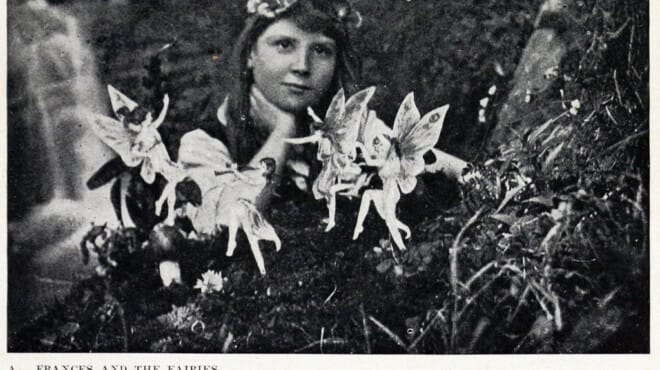The Cottingley Fairies: 100 Years of the Fairy Photographs.
18th July 2017 · 7:30pm - 9:30pm
In person | Virtual event

[soundcloud url=”https://api.soundcloud.com/tracks/333887778″ params=”auto_play=false&hide_related=false&show_comments=true&show_user=true&show_reposts=false&visual=true” width=”100%” height=”450″ iframe=”true” /]
London Fortean Society, in partnership with Conway Hall, present a night marking the centenary of the Cottingley Fairies case.
In July 1917 Elsie Wright and Frances Griffiths, 16 and 9 years old, took a photograph. It showed Frances in their garden with four fairies dancing in front of her. Two years later Elsie’s mother attended a meeting of the Theosophical Society in Bradford and by 1920 Arthur Conan Doyle wrote in the Strand Magazine.
The recognition of their existence will jolt the material twentieth century mind out of its heavy ruts in the mud, and will make it admit that there is a glamour and mystery to life.
Always controversial, the Cottingley Fairy photographs were not revealed as a hoax until Elsie and Frances confessed in 1983. They still claimed that they did fairies at the bottom of the garden.
Michael Terwey of the National Science and Media Museum in Bradford discusses how the photographs were taken and how they fitted in to the Spiritualist culture of the time and Professor Diane Purkis asks why Sherlock Holmes author Sir Arthur Conan Doyle, along with many others, so wanted to believe in fairies?
After the talks we will discuss what Cottingley and fairies meant to people in 1917 and what they mean now in 2017.
Michael Terwey – The Cottingley Fairies: a photographic hoax
In July 1917, in a small village on the fringes of the industrial city of Bradford, two young women perpetrated one of the most successful photographic hoaxes in history. Elsie Wright and Frances Griffiths convinced first their families, then many of the general public, that they had successfully photographed the fairies and gnomes that that claimed inhabited the woods at the back of their garden. It was only in the 1980s, nearly seventy years later, that they admitted their deception, and to this day there are many that believe that at least one of the photographs is “real”.
The National Science and Media Museum in Bradford holds important collections relating to the hoax, including copies of the photographs they made and the cameras that they used. In this talk Michael will explore the photographic technologies and techniques that are at the heart of the story and describe how they were used to such convincing effect, as well as looking more widely at the context of spirit and supernatural photography in the early twentieth century.
Michael Terwey is Head of Collections and Exhibitions at the National Science and Media Museum in Bradford, and responsible for the care and presentation of one of the world’s most important collections of photographic, film and television technology. He has previously worked at The National Maritime Museum in Greenwich, and for Historic Scotland, and has not, as far as he is aware, ever met a fairy.
Professor Diane Purkis – Why did Conan Doyle want to believe?
My topic is the connection between the areas and the dead, and I will be demonstrating that odd though it may seem to us, for the Victorians as for early modern Britain’s of Shakespeare’s generation, the existence of fairies with comforting and satisfying proof of the existence of a world of spirits. In addition, however, fairies could also represent the angry, restless, and hungry dead, and I will be suggesting that Conan Doyle’s interest in spiritualism meant that he was especially anxious and guilty about the dead of the First World War, an anxiety that he shared with most of the literate society of his era. I will be comparing the Cottingley pictures to Abel Gance’s 1919 film J’Accuse; I will also be referring to TS Eliot’s poem The Waste Land which came out the year the Cottingley pictures were printed in the Strand magazine.
Tickets £8